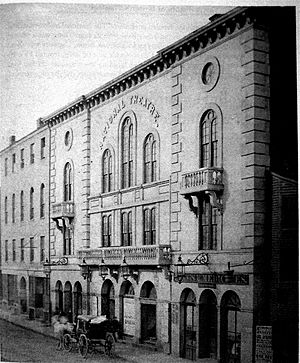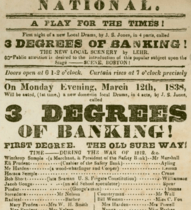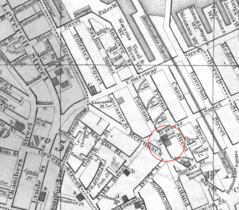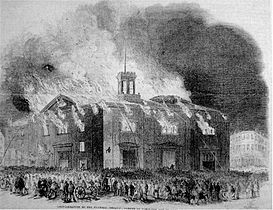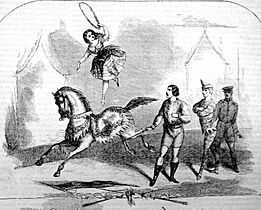National Theatre (Boston, 1836) facts for kids
The National Theatre (1836-1863) was a popular playhouse in the West End area of Boston, Massachusetts. It was a big entertainment spot in the mid-1800s. William Pelby started this theatre in 1836. He wanted to show new plays and feature American actors. The theatre was known for its amazing scenery and well-run stage shows.
Many famous performers acted here, including Edwin Adams and Mary Ann Vincent. Sadly, the theatre burned down in 1852 but was quickly rebuilt. Then, in 1863, it was destroyed by fire again and was not rebuilt after that.
Contents
Building the National Theatre
The National Theatre was designed by an architect named William Washburn. It was built on the same spot where another theatre, the Warren Theatre, used to be.
Inside the Theatre
The main theatre building was about 120 feet long and 76 feet wide. It also had another building next to it for things like refreshment rooms. The outside of the theatre looked like granite, giving it a fancy and uniform look.
Inside, the theatre had a large pit area with 600 seats. There were also three levels of special box seats, each with 336 seats. A gallery area had another 200 seats. This meant many people could watch the shows! The lobbies and refreshment areas were large and had good airflow.
The box seats were easy to get to from both streets outside. This was important for safety, allowing people to leave quickly if there was an emergency like a fire. The main roof was held up by 18 tall pine pillars. The stage opening was about 40 feet wide and 33 feet high. The stage itself was very deep, about 61 feet.
Decorations and Art
The theatre was decorated with great taste. The lowest level of box seats had paintings showing battles of the United States Navy. The second level showed the symbols of different states. The upper parts had scenes from ancient stories like the Iliad. This made the theatre a beautiful place to visit!
Plays and Performances
The National Theatre showed many different kinds of plays. They had everything from serious dramas to funny comedies. Many American writers and actors got their start here. For example, Joseph Stevens Jones wrote and put on 30 plays at this theatre.
Here are some of the plays that were performed at the National Theatre:
| Year | Play | Author |
|---|---|---|
| 1837 | Carpenter of Rouen! or The confrerie of St. Bartholomew | J.S. Jones |
| 1838 | 3 degrees of Banking | J.S. Jones |
| 1838 | Surgeon of Paris; or, The Mask of the Huguenots | Joseph Stevens Jones |
| 1838 | Hamlet | |
| 1838 | Valet de Sham | Charles Selby |
| 1839 | Moll Pitcher; or, The Fortune Teller of Lynn | |
| 1839 | Solon Shingle; or, The People's Lawyer | Joseph Stevens Jones |
| 1842 | Ivanhoe | |
| 1844 | Jack Sheppard | J.B. Buckstone |
| 1844 | Nervous Man | William Bayle Bernard |
| 1846 | Wizard of the wave! or—The ship of the avenger! | John Thomas Haines |
| 1848 | Jonathan Harrington (ventriloquist) | |
| 1849 | Serpent of the Nile | |
| 1849 | Ben the Boatswain | Thomas Egerton Wilks |
| 1849 | Mazeppa or The wild horse of Tartary | |
| 1849 | Ivanhoe! or—The knights templars | |
| 1851 | Stranger or,--Misanthropy & repentance | Kotzebue |
| 1851 | Honey moon or, how to rule a wife | John Tobin |
| 1852 | Philip Augustus of France | J. Westland Marston |
| 1852 | I've Swallowed a Policeman | |
| 1852 | Heir-at-Law | |
| 1853 | Pet of the petticoats | John Baldwin Buckstone |
| 1853 | Fortunio and his seven gifted servants | Madame d'Aulnoy/James Planché |
| 1853 | Madelaine, The Belle of the Faubourg | Virginia Cunningham |
| 1853 | Faint heart never won fair lady | J.R. Planche |
| 1853 | Wept of the Wish-ton-Wish | Wm. Bayle Bernard |
| 1853 | Tower of Nesle! or The chamber of death | George Almar, adapted from Dumas and Gaillardet's La tour de Nesle. |
| 1853 | Six degrees of crime | Frederic Stanhope Hill |
| 1853 | Gale Breezely! or, The tale of a tar | J.B. Johnstone |
| 1853 | Ernest Maltravers: or, The robber father and maniac daughter | Bulwer-Lytton |
| 1853 | Lady of Lyons | Bulwer |
| 1854 | Egyptian Prince, "the very popular Ethiopian farce" | |
| 1854 | Othello | |
| 1854 | That Good for Nothing | |
| 1854 | Faustus | |
| 1854 | Monte Cristo | |
| 1854 | Sledge Driver | Planche |
| 1854 | Much Ado About Nothing | |
| 1854 | Mary Tudor or, The artisan and the Jew | |
| 1854 | Fallen angel or Faust and Margaret | Dion Boucicault |
| 1854 | Devil's in it | |
| 1854 | Invisible prince! or, The island of tranquil delights | Planche |
| 1856 | Cushing's New York Circus | |
| 1858 | Three fast men Or, The female Robinson Crusoes | |
| 1858 | Linda, the Cigar Girl | |
| 1858 | O'Flanagan and the fairies | |
| 1858 | Buck bison: or, Baby Blanche, the child of the prairie | |
| 1858 | Woman's love Or, The secrets of the heart | |
| 1858 | Farmer's son Or, The golden axe | |
| 1859 | Inez, the poisoner | Frederic S. Hill |
| 1859 | Flowers of the Forest, A gipsey story | J.B. Buckstone |
| 1859 | Cross of gold, or Theresa's vow | |
| 1859 | Three guardsmen or, The seige [sic?] of Rochelle | |
| 1859 | Magic pills! Or, The conjuror's gift, "a grand Christmas pantomime" |
Who Ran the Theatre?
Many people managed or owned the National Theatre over the years. William Pelby was in charge for a long time, from 1836 to 1850. Other managers included William B. English, Thomas Barry, and Rosalie Pelby.
Other Names for the Theatre
Sometimes, the National Theatre was known by different names, such as:
- Willard's National Theatre (in 1856)
- People's National Theatre (in 1856 and 1859)
- Union Concert Hall (in 1862)
Images for kids


